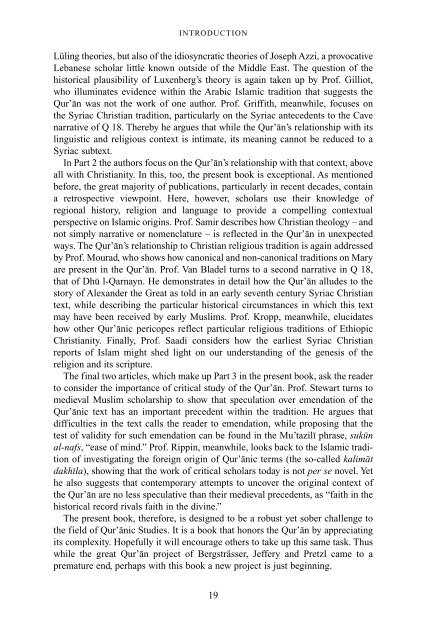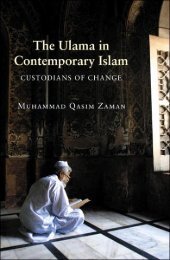The Qur'an in its historical context (pdf - Islam and Christian-Muslim ...
The Qur'an in its historical context (pdf - Islam and Christian-Muslim ...
The Qur'an in its historical context (pdf - Islam and Christian-Muslim ...
You also want an ePaper? Increase the reach of your titles
YUMPU automatically turns print PDFs into web optimized ePapers that Google loves.
INTRODUCTION<br />
Lül<strong>in</strong>g theories, but also of the idiosyncratic theories of Joseph Azzi, a provocative<br />
Lebanese scholar little known outside of the Middle East. <strong>The</strong> question of the<br />
<strong>historical</strong> plausibility of Luxenberg’s theory is aga<strong>in</strong> taken up by Prof. Gilliot,<br />
who illum<strong>in</strong>ates evidence with<strong>in</strong> the Arabic <strong>Islam</strong>ic tradition that suggests the<br />
Qur’an was not the work of one author. Prof. Griffith, meanwhile, focuses on<br />
the Syriac <strong>Christian</strong> tradition, particularly on the Syriac antecedents to the Cave<br />
narrative of Q 18. <strong>The</strong>reby he argues that while the Qur’an’s relationship with <strong>its</strong><br />
l<strong>in</strong>guistic <strong>and</strong> religious <strong>context</strong> is <strong>in</strong>timate, <strong>its</strong> mean<strong>in</strong>g cannot be reduced to a<br />
Syriac subtext.<br />
In Part 2 the authors focus on the Qur’an’s relationship with that <strong>context</strong>, above<br />
all with <strong>Christian</strong>ity. In this, too, the present book is exceptional. As mentioned<br />
before, the great majority of publications, particularly <strong>in</strong> recent decades, conta<strong>in</strong><br />
a retrospective viewpo<strong>in</strong>t. Here, however, scholars use their knowledge of<br />
regional history, religion <strong>and</strong> language to provide a compell<strong>in</strong>g <strong>context</strong>ual<br />
perspective on <strong>Islam</strong>ic orig<strong>in</strong>s. Prof. Samir describes how <strong>Christian</strong> theology – <strong>and</strong><br />
not simply narrative or nomenclature – is reflected <strong>in</strong> the Qur’an <strong>in</strong> unexpected<br />
ways. <strong>The</strong> Qur’an’s relationship to <strong>Christian</strong> religious tradition is aga<strong>in</strong> addressed<br />
by Prof. Mourad, who shows how canonical <strong>and</strong> non-canonical traditions on Mary<br />
are present <strong>in</strong> the Qur’an. Prof. Van Bladel turns to a second narrative <strong>in</strong> Q 18,<br />
that of Dhu l-Qarnayn. He demonstrates <strong>in</strong> detail how the Qur’an alludes to the<br />
story of Alex<strong>and</strong>er the Great as told <strong>in</strong> an early seventh century Syriac <strong>Christian</strong><br />
text, while describ<strong>in</strong>g the particular <strong>historical</strong> circumstances <strong>in</strong> which this text<br />
may have been received by early <strong>Muslim</strong>s. Prof. Kropp, meanwhile, elucidates<br />
how other Qur’anic pericopes reflect particular religious traditions of Ethiopic<br />
<strong>Christian</strong>ity. F<strong>in</strong>ally, Prof. Saadi considers how the earliest Syriac <strong>Christian</strong><br />
reports of <strong>Islam</strong> might shed light on our underst<strong>and</strong><strong>in</strong>g of the genesis of the<br />
religion <strong>and</strong> <strong>its</strong> scripture.<br />
<strong>The</strong> f<strong>in</strong>al two articles, which make up Part 3 <strong>in</strong> the present book, ask the reader<br />
to consider the importance of critical study of the Qur’an. Prof. Stewart turns to<br />
medieval <strong>Muslim</strong> scholarship to show that speculation over emendation of the<br />
Qur’anic text has an important precedent with<strong>in</strong> the tradition. He argues that<br />
difficulties <strong>in</strong> the text calls the reader to emendation, while propos<strong>in</strong>g that the<br />
test of validity for such emendation can be found <strong>in</strong> the Mu’tazili phrase, sukun<br />
al-nafs, “ease of m<strong>in</strong>d.” Prof. Ripp<strong>in</strong>, meanwhile, looks back to the <strong>Islam</strong>ic tradition<br />
of <strong>in</strong>vestigat<strong>in</strong>g the foreign orig<strong>in</strong> of Qur’anic terms (the so-called kalimat<br />
dakhila), show<strong>in</strong>g that the work of critical scholars today is not per se novel. Yet<br />
he also suggests that contemporary attempts to uncover the orig<strong>in</strong>al <strong>context</strong> of<br />
the Qur’an are no less speculative than their medieval precedents, as “faith <strong>in</strong> the<br />
<strong>historical</strong> record rivals faith <strong>in</strong> the div<strong>in</strong>e.”<br />
<strong>The</strong> present book, therefore, is designed to be a robust yet sober challenge to<br />
the field of Qur’anic Studies. It is a book that honors the Qur’an by appreciat<strong>in</strong>g<br />
<strong>its</strong> complexity. Hopefully it will encourage others to take up this same task. Thus<br />
while the great Qur’an project of Bergsträsser, Jeffery <strong>and</strong> Pretzl came to a<br />
premature end, perhaps with this book a new project is just beg<strong>in</strong>n<strong>in</strong>g.<br />
19



